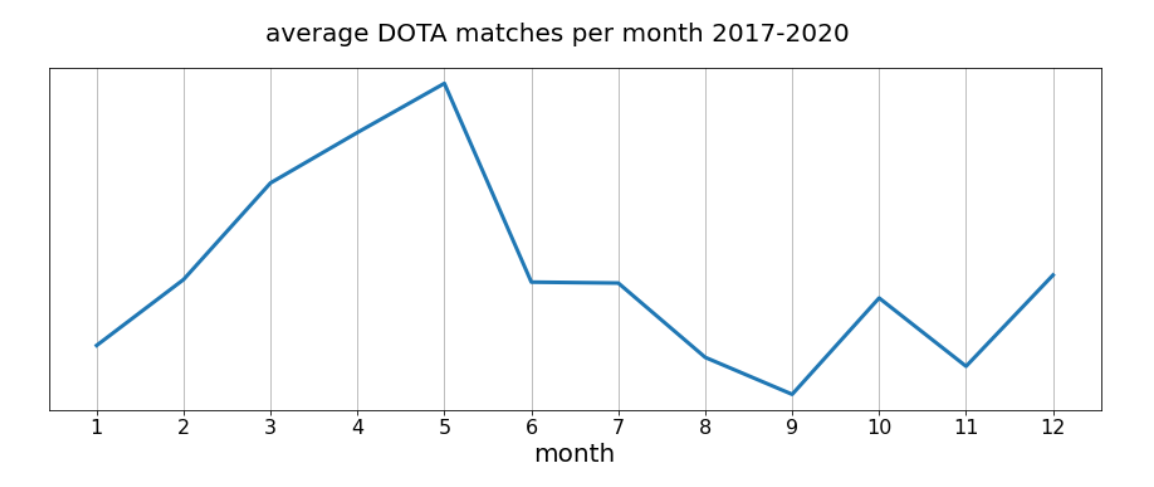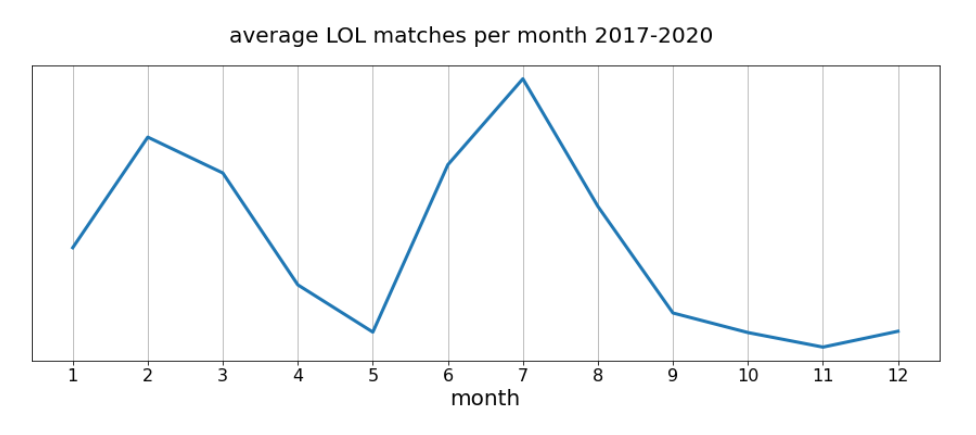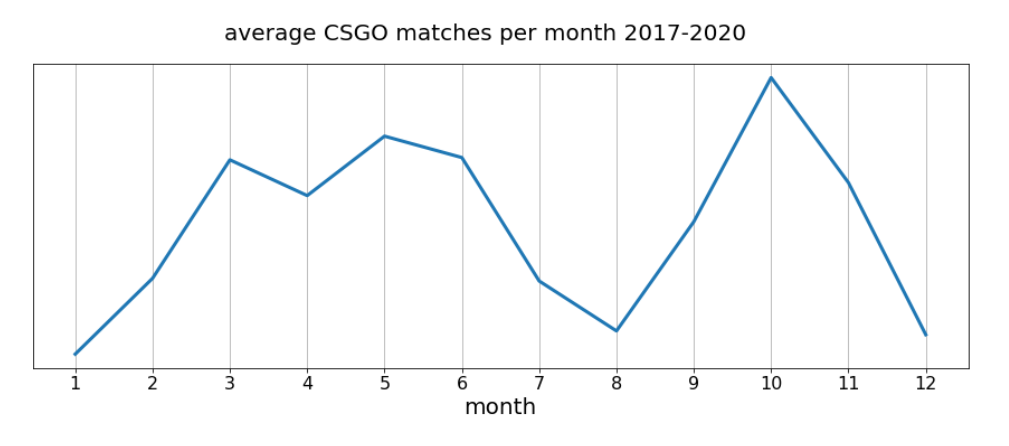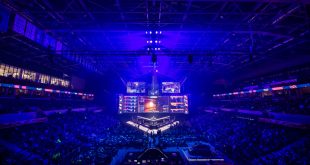Darina Goldin, Director of Data Science at Bayes Esports, takes a look at seasonal trends within the esports industry and why she learnt to embrace the chaos that comes with trying to forecast esports events in 2021.
If something is seasonal, it means that it fluctuates within a calendar year in a predictable fashion. This is true for shopping, the average temperature and, for the most part, professional sports. These are usually organised in leagues or major event series that occur every year at roughly the same time.
In tennis, you have the Grand Slam. In football, there are the Bundesliga, the Champions League, the UEFA Cup, the World Cup (every four years), and so on. You may not know who will be playing a year from now but – barring a global pandemic – you can fairly precisely say where they will be playing and when.
This is not just nice – it’s absolutely necessary when looking at professional sports from a business perspective. Players and teams need to plan their travel and training schedule. Referees, commentators and pundits know when and how much they will work each month. Sponsors need to know upcoming events so that they can allocate funds accordingly. And companies providing or using sports data can budget their year well in advance.
It’s natural to expect the same standards in esports. Professional esports have, after all, long caught up to traditional sports when it comes to prize pools, sponsorships, and production quality. When it comes to reliable event planning, however, the gap is still wide open.
As a company that processes and enriches esports data, Bayes Esports needs to know which events will happen and when for the major esports titles. But if you want to do any – and I mean any at all – esports event forecasting, you have to abandon anything you knew and bring out your glass ball. Then keep it on the table – it will only let you see a couple of months ahead each time you look.
Of course I’m being overly dramatic: things are not really that bad. We can, for instance, quite confidently say that there will be no notable matches on Christmas in the western countries and that Chinese teams will not play around Chinese New Year. That’s when teams go on a well-deserved vacation.
We can also say that the overall number of matches will grow a little bit each year for the big three: Counter-Strike, Dota 2 and League of Legends. Finally, we can unearth one more trend: no matter what happens, you can expect entire leagues to constantly be shifted, cancelled or restructured: with or without Covid.
Dota 2
Take Dota. For the longest time, the Dota Pro Circuit (DPC) consisted of Major and Minor events (with the number of events changing over the years). The events had independent organisers but were selected and co-sponsored by Valve.
Events on the DPC are usually the most prestigious and important, as they are a team’s only way to a spot at The International – the grand pinnacle of Dota 2 professional play, the game’s World Cup. But precisely because the events were hand-picked by Valve each year, they were never the same.
The number, locations and organisers of major Dota 2 events changed every season. So even if you could expect a certain event to happen long in advance, you would not know if it would have Major status for some time yet.
Let’s take ESL as an example. As one of the most significant organising bodies in the esports world, they host a number of large Dota 2 events including the ESL One series. In 2017/18, all of their events were on the DPC. In 2018/19 none of them were. In 2019/2020 the ESL One LA (that got cancelled due to COVID) made it on the Major circuit and the other events didn’t. And though ESL One Birmingham was still a very big event in the 2018/19 season – it simply wasn’t as important.
Luckily, you do not need to remember any of this – turns out even the Minor/Major system was not set in stone. This year, Valve scrapped the old system (and with it, everyone’s forecasts) in favour of a league-based system. So in the 2020/2021 season we have two leagues: One in winter and one in late spring, each followed by a Major event.
Together, these leagues and Majors will culminate in The International (which was crucially cancelled in 2020 due to international travel restrictions) Understandably, Valve is unwilling to commit to a concrete day for the event yet, as so many factors are likely to change – but if the past is any indication then the approximate date for this is in August 2021.
After TI 2021, the leagues will start up again in October. There now will be three leagues and majors: one in autumn 2021, one in winter and one in late spring 2022, followed, hopefully, by TI in August 2022.
At least this was promised, and if Valve keeps its word, we might expect a somewhat more rigid structure from the Dota 2 Professional Circuit in the future. That would be a nice change.
The leagues are scheduled in such a way that there is a top-tier match every day but Monday during this active period, which is great for fans and data providers like Bayes Esports. With approximately 180 hours per week of Dota 2 matches, we will never again be short on coverage. Here’s hoping that this league system will prove to be successful for a long time.

It bears adding that not all noteworthy Dota 2 events are on the DPC. As we already mentioned, ESL One also has a Dota 2 series that is considered to be Tier 1, along with WePlay!’s Omega League. At the time of writing, in March 2021, we do not know when most of these or other events will take place beyond April. This is not due to Covid – it’s simply how things are.
So, are you confused yet? Luckily things are about to become a little more manageable.
League of Legends
While Dota 2 just made the move to a league-oriented system, LoL has been doing it for a long time already. Riot Games (the publisher of the title) is also the sole governing entity behind the game’s professional events. This makes LoL the most seasonal of all titles we deal with. The main event of the season, the World Championship, has been played for a decade now, which is a very long time in the esports world.
All together, League of Legends has three large international events that the seasons converge to: Worlds usually take place in October, with a steadfast growing amount of teams playing for the highest glory. Winning Worlds for a LoL player is like winning the Super Bowl or the FIFA World Cup.
The second most important event is the Mid-Season Invitational, taking place in May (though it was moved to July in 2020). With one major event in spring and one in autumn, the rest of the calendar is split into two league seasons: Spring and Summer split. In each season there are twelve regional leagues in which the teams compete for a spot at Worlds.
The most prominent regions are Europe, China, Korea, and North America – showcased by how many spots they get to fill at Worlds. Each league has its own set of rules, though usually they are played in a round robin format followed by a complex playoff. The playoff rules still change from season to season and can become very complicated to follow.
Tier 2 leagues also exist in many regions and follow roughly the same time plan as tier 1 leagues. Here it is worth specifically mentioning the European region, where each country has their own regional league. The winning teams participate in the prestigious EU Masters tournament that attracts significant fan attention.

Despite its name, the Spring Season usually starts in January and culminates in playoffs at the end of March. The Summer season takes place after the Mid-Season Invitational, starting in June and with play-offs in late August-early September. The total number of matches per league can be estimated well once the amount of teams playing is known.
With this rigorous league structure, it is also easy to estimate the overall ebb and flow of League matches: Few, but high-quality matches are played in May and October-December with still few matches in early January, and a large number of weekly matches in the remaining months.
Counter-Strike: Global Offensive
We saved the gem that is CS:GO for last. Like Dota 2, CS:GO is published by Valve who also sponsors some Major and Minor events. Unlike Dota 2, there is no International or other overarching tournament akin to the World Cup. Each event operates almost as a silo – very separate and distinct from each other.
Because of that, the Majors have more prestige attached. They also happen rarely: 1-3 times a year. Majors consist of a large group stage (usually played with a modified-Swiss or a GSL system) followed by a single elimination play-off round with eight teams.
But unlike Dota 2 the Majors in CS:GO represent just the tiniest top of the iceberg. There are several leagues that result in LAN finals and are considered premium, most notably ESL Pro League, ECS and BTS.
There are prestigious events like ESL One Cologne, IEM Katowice, DreamHack Masters or Starladder. All these offer similar prize pools and are very interesting to the fans due to the high level of attending teams. They also often offer superior production value and are therefore worth more overall.
This makes Counter-Strike the game with the fullest calendar of top tier events. The problem becomes not so much finding interesting matches to have enough content to offer but selecting the most important ones – and getting the data rights for them of course!
Unfortunately, as with all titles, most of these events are not announced early enough ahead of time. We might expect them to happen – but we cannot know which month they will happen in.

One thing that exists in CS:GO are pre-arranged summer and winter breaks, decided each year by the Counter-Strike Professional Players’ Association. Both breaks last about a month and no important tournaments are supposed to be scheduled during these downtimes.
The winter break covers Christmas and Chinese New Year. The summer break is scheduled sometime between July and August. In 2021, for instance, ESL Cologne, scheduled July 6-18 will be the last international LAN before the summer break, and the season will reopen with IEM Melbourne on August 17. So while it is difficult to forecast how many CS:GO matches of note will take place between the breaks, the downtime is very predictable and known ahead of time.
Beyond the Big Three
We’ve only discussed the Big Three of esports here, because these are the titles that currently attract the most interest. It’s worth noting, however, that it was not clear which Valorant events would take place this year as late as in November 2020. For Overwatch, we have seen shifting plans and leagues ever since the title was launched.
In fact, Activision Blizzard has announced another overhaul of its Overwatch and Call of Duty Leagues just weeks before the start of the 2021 Overwatch season and with CoD 2021 season already in full play. Starcraft II premier events have not been announced beyond July 2021 yet. Quake, another legacy game, received its new Quake Pro League only two years ago.
Sure, some of these uncertainties can be explained by Covid – major tournaments have offline finals, but how can you plan an international offline event if you cannot even plan your own vacation?
But most of these issues have existed long before Spring 2021. And it’s hardly surprising. Esport, overall, is still very young. You will be hard pressed to find an esports title older than ten years with a significant competitive scene. Conversely new titles are being launched every year and vye for a spot in the sun with yet another tournament structure. We are still in the testing and growing phase here. It is okay that things change.
What is not okay however, is how late these changes are sometimes being communicated. It’s hard to imagine that large organisers truly don’t know which event they are planning to host. The lack of transparency and communication here is a detriment to the popularity of esports. It is hard to communicate to outsiders.
As Bayes Esports urged in our recent whitepaper, tournament organisers should strive to professionalise their approaches to data and timing. This is understandably harder to do in 2020/21, but should still be the overall industry goal.
All organisations that work in esports need this information sooner rather than later. Any business operating needs to plan revenue, and for this it’s necessary to know how many matches will be played and when. This data is absolutely crucial for the esports industry to continue its current growth and professionalisation. But it simply doesn’t exist! And will not exist for at least another few years.
There is however a silver lining. 2020 was not a typical year and neither is 2021. Sports (and esports, albeit far less often) events were cancelled left, right and center. Every forecast for traditional sports went down the drain.
But Bayes Esports was fine – we were used to anything happening at any time. This is the one advantage of being a data scientist in esports: there never has been a normal year. We have never known which events are coming or when. But we always manage to get the data right anyway.









